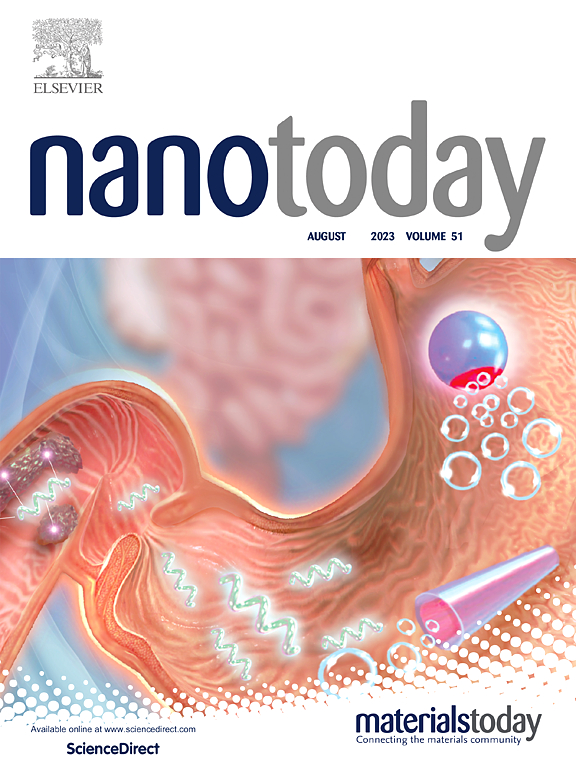Utilizing oxygen vacancies in cerium oxide to narrow the gap between d and f band centers for efficient alkaline water oxidation
IF 13.2
1区 材料科学
Q1 CHEMISTRY, MULTIDISCIPLINARY
引用次数: 0
Abstract
Rare earth oxides (REOs) hold a pivotal position in enhancing electrocatalytic performance, yet the comprehension of their underlying mechanisms poses significant challenges. In this study, REOs loaded with a ternary alloy, abundant in oxygen vacancies, were synthesized through a one-pot reduction method and exhibited remarkable oxygen evolution reaction (OER) activity. The interaction at the interface between Fe0.3NiCo and CeO2 induced substantial lattice distortion and modulated the oxygen vacancy concentration within the REOs. A unique electron transport channel, incorporating transition metal (3d) -oxygen vacancy (Vo) -rare earth (4 f) elements, was constructed at the interface, significantly boosting the OER activity of NiCo-CeO2. Notably, a current density of 10 mA cm−2 was achieved at a low overpotential of 151 mV. Comprehensive characterizations revealed that the interplay between the alloy and REOs regulated the oxygen vacancy concentration of the latter. In-situ attenuated total reflection infrared spectroscopy (ATR-IR) further confirmed that REOs facilitated the adsorption of O2/-OH, thereby enhancing OER activity. Theoretical calculations also indicated that oxygen vacancies effectively shifted the d and f band centers near the Fermi level, promoting d-f electron exchange and ensuring efficient electron transfer. This study offers a novel perspective for the development of efficient RE-based catalysts.
利用氧化铈中的氧空位来缩小d和f带中心之间的间隙,以实现高效的碱性水氧化
稀土氧化物(REOs)在提高电催化性能方面具有举足轻重的地位,但对其潜在机制的理解却面临着重大挑战。本研究采用一锅还原法制备了氧空位丰富的三元合金负载reo,并取得了良好的析氧反应(OER)活性。Fe0.3NiCo和CeO2在界面处的相互作用引起了大量的晶格畸变,并调节了REOs内的氧空位浓度。在界面处构建了过渡金属(3d) -氧空位(Vo) -稀土(4 f)元素的独特电子传递通道,显著提高了NiCo-CeO2的OER活性。值得注意的是,在151 mV的低过电位下,电流密度达到了10 mA cm−2。综合表征表明,合金与REOs的相互作用调节了REOs的氧空位浓度。原位衰减全反射红外光谱(ATR-IR)进一步证实REOs促进了O2/-OH的吸附,从而增强了OER活性。理论计算还表明,氧空位有效地移动了费米能级附近的d和f带中心,促进了d-f电子交换,确保了有效的电子转移。本研究为开发高效稀土基催化剂提供了新的思路。
本文章由计算机程序翻译,如有差异,请以英文原文为准。
求助全文
约1分钟内获得全文
求助全文
来源期刊

Nano Today
工程技术-材料科学:综合
CiteScore
21.50
自引率
3.40%
发文量
305
审稿时长
40 days
期刊介绍:
Nano Today is a journal dedicated to publishing influential and innovative work in the field of nanoscience and technology. It covers a wide range of subject areas including biomaterials, materials chemistry, materials science, chemistry, bioengineering, biochemistry, genetics and molecular biology, engineering, and nanotechnology. The journal considers articles that inform readers about the latest research, breakthroughs, and topical issues in these fields. It provides comprehensive coverage through a mixture of peer-reviewed articles, research news, and information on key developments. Nano Today is abstracted and indexed in Science Citation Index, Ei Compendex, Embase, Scopus, and INSPEC.
 求助内容:
求助内容: 应助结果提醒方式:
应助结果提醒方式:


